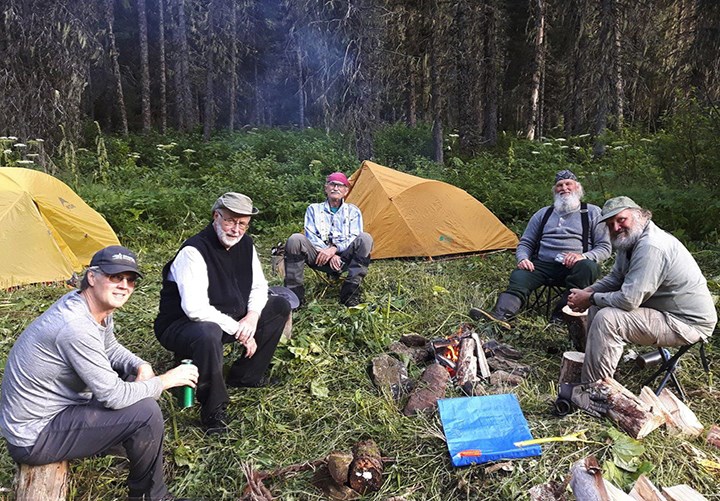The goal of completing northern B.C.’s section of the National Hiking Trail got a boost in the form of a $203,000 grant to upgrade the Historic Goat River Trail.
“We would not have a cross-Canada trail without the Goat, or without any of those trails that are historic up there,” said Patrick Harrison, president of the National Hiking Trail.
The Historic Goat River Trail was originally commissioned in 1886 as a gold rush trail along the Goat River, and was reportedly used during Prohibition in the early 1900s to deliver bootleg liquor to railway construction camps along the Fraser River.
The trail was reactivated by Fraser Headwaters Alliance in the late 1990s to bring attention to environmental issues in the area and protect the Goat River watershed.
Funding from the province, announced last month, is part of a $90 million community economic recovery infrastructure program to support economic resilience, tourism, heritage, and economic development.
The money will help Fraser Headwaters Alliance with essential upgrades to keep the trail functioning, including fixing a river-crossing cable car system and building a 17-kilometre reroute to move the trail off a deactivated logging road and around a clearcut.
“The cable car is pretty good itself, but it needs to be lifted up off the water and stabilized,” said Roy Howard, one of the founders of the alliance. “Right now we've got the support cable just hanging on a couple of trees and we want to get it up so it's free-standing and a lot more solid.
The work couldn’t be done by volunteers, let alone on a non-profit budget, Howard said.
The second upgrade is 17 kilometres of rerouting of the trail near Bowron Provincial Park which will partially follow a path rediscovered by alliance director Simon Zukowski when he and a friend were scouting possible reroute trajectories last summer.
“We bushwhacked up Mount Kruger and stumbled on this trail that was already there. It was beautiful. We were amazed,” said Zukowski. “It had just kind of been forgotten.”
The trail had been cut by the former area trapper-outfitter and his father, and hadn’t been used since the 1990s when natural forces destroyed parts of it.
The old trapper path will make up a good portion of the rerouting, said Zukowski, who will oversee the trail construction this summer.
“We focus an awful lot of attention on the Goat River Trail,” said Howard. “That's probably the main thing that Fraser Headwaters Alliance does.”
The trail currently spans about 65 kilometres from around Crescent Spur to Bowron Lake. It includes the proposed Goat River Protected Area, which the alliance wants turned into protected parkland, and is mainly used by long-distance hikers, he said.
In the early 2000s, the alliance’s work helped make the Goat River Trail the first leg of B.C.’s National Hiking Trail, a cross-country footpath concept still in-the-making. The intention was to build on existing historic trails used by Indigenous people, fur traders and early explorers, and ultimately join them into one continuous trail across Canada, similar to the former TransCanada Trail idea (now the Great Trail).
“The Goat River Trail wouldn't exist if it wasn't for Roy and all the work he's done over the years,” said Dave King, a hiking guide with the Caledonia Ramblers Hiking Club and an editor of the Central Interior Trail Guide. The Caledonia Ramblers do similar trail stewardship work around the Prince George region and beyond.
In northern B.C., the plan is to link a series of historic trails from Bella Coola to the Rockies, connecting to the existing Great Divide Trail, which will make up the province’s portion of the National Hiking Trail.
“If it wasn't for the efforts put in by groups like the Caledonia Ramblers and the Fraser Headwaters Alliance, a lot of these trails would probably get lost,” said King, a former wildlife biologist with the provincial ministry of the environment. “BC Parks, and Recreation Sites and Trails have got so many trails under their jurisdiction that they just do not have the resources to look after them.”
The alliance also looks after the East Twin-Chalco Trail, east of the Goat trail, which the group is working on connecting to the 1,100-kilometre Great Divide Trail, spanning from Kakwa in the northern interior, to Waterton in Alberta.
“We would tie (Chalco) into the Rockies, then use the Great Divide Trail to get down as far as Banff,” Howard said.
The Chalco trail will provide an access point on the long and especially wild portion of the Great Divide trail between Mount Robson and Kakwa, improving hiking options and safety for users, said Brad Vaillancourt, president of the Great Divide Trail Association.
The work Howard and his group are doing is important, Vaillancourt said. “It's slow, slow progress, but they're got a dream and a vision and that's pretty cool.”



